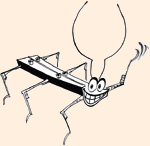|

Stiquito For Beginners : An Introduction to Robotics

 This is the second book on the popular
Stiquito robot. Stiquito for Beginners is much more basic than the original book.
It is aimed at the novice and it presents you with a unique opportunity to learn about the
fields of engineering, electronics, and robotics in an original way. This is the second book on the popular
Stiquito robot. Stiquito for Beginners is much more basic than the original book.
It is aimed at the novice and it presents you with a unique opportunity to learn about the
fields of engineering, electronics, and robotics in an original way.
This book may also be the first affordable educational book to
describe a robot and include the robot with the book! This book will provide you with the
skills and equipment to build a small robot, and will also provide you with instructions
on how to build electronic controls for your robot.
The star of this book is Stiquito, a small, inexpensive hexapod
(six-legged) robot. Stiquito has been used since 1992 by universities, high schools, and
hobbyists. It is unique not only because it is so inexpensive but because its applications
are limitless.
The
Stiquito is a robot that is intended for use as a research and educational tool. This book
is written at a level for High School and College students. It provides an engineering,
electronics, and robotics curriculum, and presents experiments and projects that
illustrate what they teach. It also illustrates Stiquito's uses in education by presenting
lab exercises and describes the use of nitinol in experiments. Stiquito has already
successfully been used to teach in primary, secondary, high school, and college classes.
 Contents: Chapter 1: An Introduction to Robotics and
Stiquito — This chapter presents a brief overview of robotics and describes the
Stiquito robot. This chapter will also describe the skills needed to build a Stiquito
robot. Contents: Chapter 1: An Introduction to Robotics and
Stiquito — This chapter presents a brief overview of robotics and describes the
Stiquito robot. This chapter will also describe the skills needed to build a Stiquito
robot.
Chapter 2: Engineering Skills and the Design Process
— What is an engineer? What skills do an engineer need? How does an engineer go about
designing something? This chapter explores these questions.
Chapter 3: Electricity Basics — This chapter
discusses some of the basic properties of electricity. This chapter also provides some
experiments to show how electricity and electronic components work.
Chapter 4: Nitinol Basics — This chapter discusses
some of the basic properties of the Stiquito's muscle, nitinol wire. It also provides some
experiments to show how electricity and nitinol work.
 Chapter 5: Stiquito: A Small,
Simple, Inexpensive Hexapod Robot — This chapter gives step-by-step instructions on
how to assemble the robot kit included in the book. Chapter 5: Stiquito: A Small,
Simple, Inexpensive Hexapod Robot — This chapter gives step-by-step instructions on
how to assemble the robot kit included in the book.
Chapter 6: A Manual Controller for the Stiquito Robot
— You have finished building the robot kit. Now how do you make it walk? This chapter
gives step-by-step instructions on how to build the simplest tethered controller for
Stiquito.
Chapter 7: A PC Based Controller for the Stiquito Robot — This
interface allows you to use an IBM PC or compatible computer to control the actuators on
the Stiquito robot and experiment with various gaits.
Chapter 8: A Simple Circuit to Make Stiquito Walk on Its Own —
This chapter contains detailed instructions on how to build an electrical controller to
allow Stiquito to walk autonomously.
Chapter 9: Uses of Stiquito and the Future of Small Walking Robots
— Now that you have built Stiquito, what can you do with it? What can it be used for
in the future? This chapter explores these questions.
|
A biography, a list of suppliers, and an index are also included. The book includes all materials needed to build Stiquito.
You only need a hobby knife,
pliers, and a battery to complete the robot.
We recommend this
book!
|
|

Stiquito Controlled! : Making a Truly
Autonomous Robot

 Build your own Stiquito "walking-stick" robot insect with the included kit! Build your own Stiquito "walking-stick" robot insect with the included kit!
Stiquito Controlled! is a widely accessible, user-friendly book that
provides step-by-step instructions for building Stiquito, a small,
multi-legged robot that resembles a "walking-stick" insect. The book
includes comprehensive instructions and all the parts needed to complete
assembly. Most notably, the kit contains a microcontroller board that allows
Stiquito to walk on its own. Key features of the book include:
Complete kit to build Stiquito—no additional materials necessary (common
tools required)
Detailed, step-by-step instructions for assembly of the robot
Comprehensive lessons on making Stiquito walk using the
microcontroller
Engineering teachers and students, researchers, and science enthusiasts will
find Stiquito Controlled! a fascinating and fun hands-on project. |
|

Shape Memory Materials

 Shape
memory materials are fascinating materials, with the potential for
application as "smart materials" and also as new functional materials. This
book presents a systematic and up-to-date account of all aspects of shape
memory materials, from fundamentals to applications. Starting from the basic
principles of the martensitic transformation, on which the shape memory
effect and the super-elasticity of alloys are based, the mechanisms of the
two phenomena are clearly described, together with possible applications.
The characteristics, fabrication techniques and thermo-mechanical treatment
of various shape memory alloys are described in detail, with special
emphasis on Ti-Ni and Ti-Ni-X (with X being Cu, Fe etc.) alloys. Shape
memory materials are fascinating materials, with the potential for
application as "smart materials" and also as new functional materials. This
book presents a systematic and up-to-date account of all aspects of shape
memory materials, from fundamentals to applications. Starting from the basic
principles of the martensitic transformation, on which the shape memory
effect and the super-elasticity of alloys are based, the mechanisms of the
two phenomena are clearly described, together with possible applications.
The characteristics, fabrication techniques and thermo-mechanical treatment
of various shape memory alloys are described in detail, with special
emphasis on Ti-Ni and Ti-Ni-X (with X being Cu, Fe etc.) alloys.
|
The book also describes various applications and design principles, for example in
actuators, medical applications and as smart materials. The book contains
chapters on shape memory ceramics and polymers as well as shape memory
alloys, making it a comprehensive account of the field. |
|
|
 This is the second book on the popular
Stiquito robot. Stiquito for Beginners is much more basic than the original book.
It is aimed at the novice and it presents you with a unique opportunity to learn about the
fields of engineering, electronics, and robotics in an original way.
This is the second book on the popular
Stiquito robot. Stiquito for Beginners is much more basic than the original book.
It is aimed at the novice and it presents you with a unique opportunity to learn about the
fields of engineering, electronics, and robotics in an original way. Contents: Chapter 1: An Introduction to Robotics and
Stiquito — This chapter presents a brief overview of robotics and describes the
Stiquito robot. This chapter will also describe the skills needed to build a Stiquito
robot.
Contents: Chapter 1: An Introduction to Robotics and
Stiquito — This chapter presents a brief overview of robotics and describes the
Stiquito robot. This chapter will also describe the skills needed to build a Stiquito
robot.  Chapter 5: Stiquito: A Small,
Simple, Inexpensive Hexapod Robot — This chapter gives step-by-step instructions on
how to assemble the robot kit included in the book.
Chapter 5: Stiquito: A Small,
Simple, Inexpensive Hexapod Robot — This chapter gives step-by-step instructions on
how to assemble the robot kit included in the book.  Build your own Stiquito "walking-stick" robot insect with the included kit!
Build your own Stiquito "walking-stick" robot insect with the included kit!
 Shape
memory materials are fascinating materials, with the potential for
application as "smart materials" and also as new functional materials. This
book presents a systematic and up-to-date account of all aspects of shape
memory materials, from fundamentals to applications. Starting from the basic
principles of the martensitic transformation, on which the shape memory
effect and the super-elasticity of alloys are based, the mechanisms of the
two phenomena are clearly described, together with possible applications.
The characteristics, fabrication techniques and thermo-mechanical treatment
of various shape memory alloys are described in detail, with special
emphasis on Ti-Ni and Ti-Ni-X (with X being Cu, Fe etc.) alloys.
Shape
memory materials are fascinating materials, with the potential for
application as "smart materials" and also as new functional materials. This
book presents a systematic and up-to-date account of all aspects of shape
memory materials, from fundamentals to applications. Starting from the basic
principles of the martensitic transformation, on which the shape memory
effect and the super-elasticity of alloys are based, the mechanisms of the
two phenomena are clearly described, together with possible applications.
The characteristics, fabrication techniques and thermo-mechanical treatment
of various shape memory alloys are described in detail, with special
emphasis on Ti-Ni and Ti-Ni-X (with X being Cu, Fe etc.) alloys.